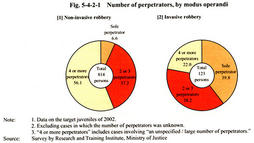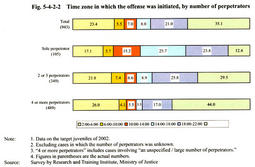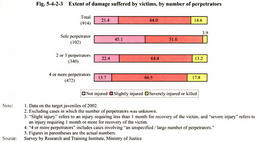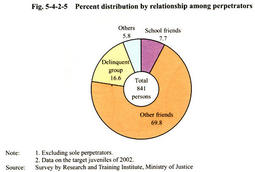| Previous Next Index Image Index Year Selection | |
|
|
1 Analysis of the increase in the number of perpetrators per case and escalation of violence in robbery cases As shown in Chapter 3, Section 2 , the overwhelming majority of robbery cases committed by juveniles have been cases of non-invasive robbery, and in particular street robbery, and the number of cases committed by sole perpetrators has been quite small whereas the number of cases committed by multiple perpetrators has been increasing in recent years. This trend is also shown in the results of this survey. Furthermore, this survey has revealed that there is an interesting relationship between the number of perpetrators per case and the mode of the offense.
Fig. 5-4-2-1 shows the number of perpetrators per case by modus operandi. In the category of invasive robbery, the target juveniles who committed robbery in solo account for about 40% and those who committed robbery in a group of 4 or more perpetrators account for slightly over 20%. In the category of non-invasive robbery, on the other hand, those who committed robbery in solo account for below 10% while those who committed robbery in a group of 4 or more perpetrators accounting for the majority. This indicates that the accomplice rate, and in particular the accomplice rate for cases involving 4 or more perpetrators, is extremely high among the target juveniles who committed robbery outdoors. Fig. 5-4-2-1 Number of perpetrators, by modus operandi Fig. 5-4-2-2 Time zone in which the offense was initiated, by number of perpetrators Fig. 5-4-2-2 shows the time zone in which the offense was initiated, by number of perpetrators. Most of the target juveniles committed robbery at night (from 18:00 to 6:00; 79.5%) and late at night (from 22:00 to 2:00; 35.1%). This tendency intensifies as the number of perpetrators becomes larger.Fig. 5-4-2-3 shows the extent of damage to victims, by number of perpetrators. Of the target juveniles, 64.0% were involved in cases in which victims were injured slightly and 14.6% were involved in cases in which victims were injured severely or killed. Thus, juvenile robbery offenders are more likely to be involved in cases in which victims are damaged, and in particular, the extent of damage to victims becomes more serious as the number of perpetrators involved per case becomes larger. Fig. 5-4-2-3 Extent of damage suffered by victims, by number of perpetrators Fig. 5-4-2-4 [1] and [2] show the percentage of the target juveniles who recognized that violence escalated more than expected while they were committing the offense, by extent of damage to victims and by leadership respectively. More than half of the target juveniles recognized that violence escalated more than expected, and the percentage of those having such recognition becomes larger as the extent of damage to victims becomes more serious. According to the relationship among perpetrators, the percentage of the target juveniles having such recognition is the largest among those who acted as leader, followed by the percentage among those who acted without leader, and the percentage among those who acted along with a leader. It is clearly revealed that slightly more than 40% of those who acted as leader and nearly 60% of those who were sole perpetrators recognized the escalation of violence. In accomplice cases (cases involving 2 or more perpetrators), juvenile robbery offenders who participated less proactively in the offense recognized that their conduct had brought about unexpected results. Even among those who were sole perpetrators or acted as leader, many considered in hindsight that their conduct had brought about results that they had never expected in the beginning, stating that they could not stop themselves at the scene of the offense and finally damaged victims.Fig. 5-4-2-4 Percentage of juvenile robbery offenders who recognized the escalation of violence Fig. 5-4-2-5 shows the percent distribution of the target juveniles, by relationship among perpetrators. Those who committed robbery with friends account for the largest share at 69.8% whereas those who committed robbery with delinquent groups account for only 16.6%. The percentage of the target juveniles involved in cases in which juveniles who had previously been admitted in juvenile training schools or convicted (including the target juveniles concerned) were also involved is not so large, at 21.5%. With respect to the extent of damage to victims, by type of complicity, "not injured," "slightly injured," and "severely injured/killed" account for 14.5%, 61.1 %, and 24.4% respectively among those who committed robbery with "delinquent groups," and for 18.7%, 66.3%, and 15.0% respectively among those who committed robbery with "friends". Thus, victims are damaged less severely in cases committed by juveniles with "friends" than in cases committed by juveniles with "delinquent groups," but this also suggests that victims are severely injured in some robbery cases committed by juveniles with friends who are not regarded as antisocial groups. Comparing the target juveniles who committed robbery with juveniles who had previously been admitted to juvenile training schools or convicted and those who committed robbery without such juveniles, "not injured," "slightly injured," and "severely injured/killed" account for 15.1%, 67.6%, and 17.3% respectively among the former, and for 23.2%, 63.2%, and 13.6% respectively among the latter. Thus, the percentage of "not injured" is larger and the percentage of "severely injured/killed" is smaller among cases in which juveniles who had previously been admitted in juvenile training schools or convicted were involved than among cases in which such juveniles were not involved, but even in the latter cases, the victims were sometimes severely injured.Fig. 5-4-2-5 Percent distribution by relationship among perpetrators |




